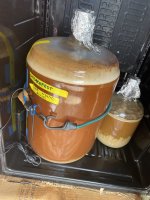You're probably correct. I can't remember everything I've read on the topic at this point. It's not something I consider a problem, it always dissipates if I give the yeast enough time. What I'm really after is clarity. I have had a few batches that just never seem to clear as much as I'd like and without exception, my best tasting beers have been the clearest.I do not think that there is any connection between trub and diacetyl production.
I'm fairly certain it is diacetyl. The flavor is there in almost every batch to one extent or another, often with the slickness in the mouth. Time fixes it, but there are definitely times when I've had a batch at FG for several days but waited to package until I couldn't taste the diacetyl anymore. I use a Spike Flex+ so I sometimes take small samples along the way because I'm curious about how things smell & taste at various stages of the process.Are you certain that it is in fact diacetyl when you think you're tasting diacetyl?
































![Craft A Brew - Safale S-04 Dry Yeast - Fermentis - English Ale Dry Yeast - For English and American Ales and Hard Apple Ciders - Ingredients for Home Brewing - Beer Making Supplies - [1 Pack]](https://m.media-amazon.com/images/I/41fVGNh6JfL._SL500_.jpg)

























